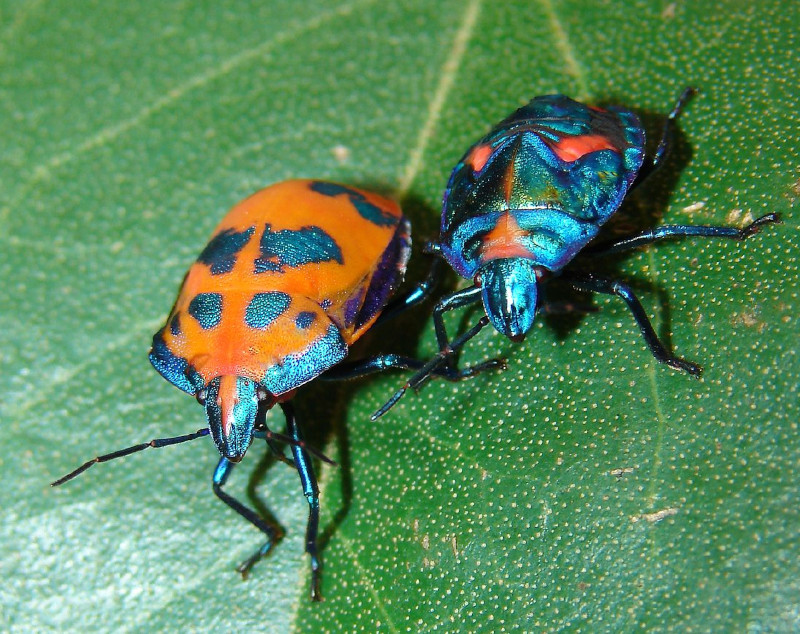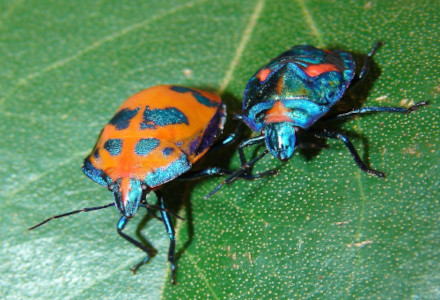
Hibiscus Harlequin Bug Facts
- This brilliantly colored Arthropod most frequently goes by the intriguing, though informative, common name of the Hibiscus Harlequin Bug. It also has another, less often used, general name. That’s the equally accurate term of the cotton harlequin bug.
- Among scientific professionals, such as researchers, however, the insect’s typically referred to by its official scientific name. That’s an extremely hard to pronounce term, though. That’s because it bears the official moniker of the Tectocoris diophthalmus.
- There’s a story to the naming of this marvel, however. The creature further received that appellation at the hands of the respected Swedish naturalist, Carl Peter Thunberg. This scientifically noteworthy deed he further accomplished in the year 1783.
- Sometimes considered an apostle of Carl Linnaeus, he made the first acknowledgment of it as a separate and distinct species. Yet, regardless of which term one chooses to employ for the species, it represents the only known member of its genus.
- Fortunately for the Hibiscus Harlequin Bug, it appears to be maintaining a population base that’s both stable and sufficient. This stability further seems to hold true throughout its range. The IUCN, therefore, has no current listing for it on its Red List.
- This product of evolution nonetheless faces several threats to its existence. It’s considered a pest in some regions, and faces active efforts at controlling its population. Like most other species around the world, it also faces the danger of climate change.
Related Articles
Hibiscus Harlequin Bug Physical Description
It’s worth noting that the magnificent Hibiscus Harlequin Bug fully merits its reputation for colorfulness regardless of physical size. That’s because it remains only an average-sized member of its Order. Nature, however, holds no regard for such distinctions.
Although the intriguing insect does display the physiological characteristic of sexual dimorphism, it does not do so in terms of size. Individuals of both genders, therefore attain the same average overall body length. That only equals roughly 0.8 in (2 cm), though.
That physical form of this impressive member of the Hemiptera Order further develops what some call a shield shape. This consists of a rounded, somewhat convex pattern of development. The colors presented also generally tend to display a metallic sheen.
It’s in those color patterns presented that the Hibiscus Harlequin Bug displays the gender-based differences. Adult female specimens show a primarily orange background, though spotted with blue. Males, though, show mostly blue, with spots of red and orange.
Its head, however, develops as comparatively elongated in design. This holds especially true compared to certain other insects. It also has two long, slender antennae, for sensing. Its six multi-jointed legs further possess a thin covering of short, bristly hairs along their length.
- Kingdom: Animalia
- Phylum: Arthropoda
- Class: Insecta
- Order: Hemiptera
- Family: Scutelleridae
- Genus: Tectocoris
- Species: T. diophthalmus
Hibiscus Harlequin Bug Distribution, Habitat, and Ecology
The visually appealing Hibiscus Harlequin Bug evolved as native to a general region of the world already renowned for its incredible forms of life. That zone of habitation principally includes the continent of Australia. Even there, though, it only appears in the east.
The intrepid small animal also evolved as endemic to a few other tiny areas, however. More precisely, the other regions in which it appears include New Guinea and several scattered Pacific Islands. There, though, the insect manifests smaller population groupings.
In all regions in which it does make an appearance, however, it displays an impresive adaptability in its habitat preferences. That’s because it inhabits widely different ecosystems. These include rainforests, open forests, coastal dunes, and even private gardens.
It further displays little or no preference for altitudes, though none of the regions in which it lives in possess any areas of significant elevation. Population concentrations, furthermore, seem to be approximately equally divided between sea level elevations and up.
It’s the feeding habits of the gorgeous Hibiscus Harlequin Bug, though, that garner the most attention from most people aware of it. That’s due to the fact that the amazing species feeds on the sap of several species. It does this by piercing the stems of young plants.
The creature also displays a strong preference in the plants it feeds on. These mainly include species of hibisucs in the Malvaceae family, thus the name. Yet it also consumes the sap of a few other species, including culitvated cotton, and bottlebrush, among others.
Species Sharing Its Range
Check out our other articles on 3 Particularly Pleasing Porpoises, Blainville’s Beaked Whale, Victoria Falls, New Zealand Giraffe Weevil, California red-sided garter snake

